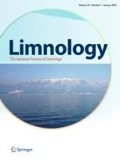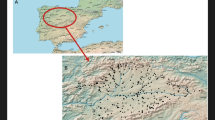Abstract
We investigated the relationships between major nutrients (C, H, N, and P) and trace metals (Cu, Fe, and Mn) in seston samples from ten lake/lagoon systems in southern Brazil. The systems were characterized by a diverse set of limnological features, including surface areas from 10−1 to 102 km2, water color, a CDOM(440), from 1.4 to 12.9 m−1, and electrical conductivity from 50 to 100 000 μS cm−1. Seston concentrations also varied a great deal, 32-fold. The elemental (C: N, C: P, and N: P) and C: Chl-a ratios in the seston samples indicated, however, common features; i.e., most of the lakes were N-and/or P-limited, and the seston organic fraction was composed of nonvascular plants (e.g., phytoplankton). Our intersystem comparison revealed that the relative content of organic matter in seston and seston concentrations in lake water tended to correlate positively and negatively, respectively, with trace metal concentrations across the seston samples. Possible influences of elemental and C: Chl-a ratios on the association of metals with seston matrices, although theoretically important, were only partially evidenced here; positive correlations were found between C: N and also Org-H: N ratios with trace metal concentrations. We speculate that such results could be circumstantial, as the nature of the seston matrices appeared to be very similar among them. This hypothesis should thus be the theme of further research. In short, our findings suggest that C: N and Org-H: N ratios as well as the relative content of major nutrients in seston and seston concentrations can be importantly related to trace metal concentrations in seston samples. In discussing the results, however, we consider that metal-seston relationships depend on a variety of physical, chemical, and biological factors and/or variables other than those measured in this study, which could also contribute for defining and explaining variations in metal-seston concentrations in lake ecosystems.
Similar content being viewed by others
References
Barillé-Boyer A-L, Barillé L, Massé H, Razet D, Héral M (2003) Correction for particulate organic matter as estimated by loss on ignition in estuarine ecosystems. Estuar Coast Shelf Sci 58:147–153
Copin-Montegut C, Copin-Montegut G (1983) Stoichiometry of carbon, nitrogen, and phosphorus in marine particulate matter. Deep Sea Res 30:31–46
Cullen JT, Sherrell RM (1999) Techniques for determination of trace metals in small samples of size-fractionated particulate matter: phytoplankton metals off central California. Mar Chem 67:233–247
Dankers N, Laane R (1983) A comparison of wet oxidation and loss on ignition of organic material in suspended matter. Environ Technol Lett 4:283–290
Falkowski PG (1994) The role of phytoplankton photosynthesis in global biogeochemical cycles. Photosynth Res 39:325–258
Fisher NS (1986) On the reactivity of metals for marine phytoplankton. Limnol Oceanogr 31:443–449
Förstner U, Wittman GTW (1983) Metal pollution in the aquatic environment. Springer-Verlag, New York
Gibbs RJ (1986) Segregation of metals by coagulation in estuaries. Mar Chem 18:149–159
Goldman JC (1980) Physiological processes, nutrient availability, and the concept of relative growth rate in marine phytoplankton ecology. Brookhaven Symp Biol 31:179–194
González-Dávila M (1995) The role of phytoplankton cells on the control of heavy metal concentration in seawater. Mar Chem 48:215–236
Hamilton-Taylor J, Davison W (1995) Redox-driven cycling of trace elements in lakes. In: Lerman A, Imboden D, Gat J (eds) Physics and chemistry of lakes. Springer-Verlag, New York, pp 217–263
Healey FP (1973) Inorganic nutrient uptake and deficiency in algae. Crit Rev Microbiol 3:69–113
Healey FP, Hendzel LL (1980) Physiological indicators of nutrient deficiency in lake phytoplankton. Can J Fish Aquat Sci 37:442–453
Hecky RE, Kilham P (1988) Nutrient limitation of phytoplankton in freshwater and marine environments: a review of recent evidence on the effects of enrichment. Limnol Oceanogr 33:796–822
Hecky RE, Campbell P, Hendzel LL (1993) The stoichiometry of carbon, nitrogen, and phosphorus in particulate matter of lakes and oceans. Limnol Oceanogr 38:709–724
Hedges JI, Baldock JÁ, Gélinas Y, Lee C, Peterson ML, Wakeham SG (2002) The biochemical and elemental compositions of marine plankton: a NMR perspective. Mar Chem 78:47–63
Hongve D (1994) Nutrient metabolism (C, N, P, and Si) in the trophogenic zone of a meromictic lake. Hydrobiologia 277:17–39
Hutchins DA, Bruland KW (1998) Iron-limited diatom growth and Si: N uptake ratios in a coastal upwelling regime. Nature (Lond) 393:561–564
Karageorgis AP, Nikolaidis NP, Karamanos H, Skoulikidis N (2003) Water and sediment quality assessment of the Axios River and its coastal environment. Continental Shelf Res 23:1929–1944
Kilham P, Hecky RE (1988) Comparative ecology of marine and freshwater phytoplankton. Limnol Oceanogr 33:776–795
Killops SD, Killops VJ (1994) An introduction to organic geochemistry. Longman, Singapore
Kirk JTO (1994) Light and photosynthesis in aquatic ecosystems, 2nd edn. Cambridge University Press, Cambridge
Knauer GA, Martin JH (1973) Seasonal variations of cadmium, copper, manganese, lead, and zinc in water and phytoplankton in Monterey Bay, California. Limnol Oceanogr 18:597–604
Koelmans AA (1998) Geochemistry of suspended and settling solids in two freshwater lakes. Hydrobiologia 364:15–29
Li D, Daler D (2004) Ocean pollution from land-based sources: East China Sea, China. Ambio 33:107–113
Markert B, Pedroso F, Geller W, Friese K, Korhammer S, Baffico G, Díaz M, Wölfl S (1997) A contribution to the study of the heavymetal and nutritional element status of some lakes in the southern Andes of Patagonia (Argentina). Sci Total Environ 206:1–15
Meyers PA, Ishiwatari R (1995) Organic matter accumulation records in lake sediments. In: Lerman A, Imboden D, Gat J (eds) Physics and chemistry of lakes. Springer-Verlag, New York, pp 279–328
Morel FMM, Hudson RJM (1985) The geobiological cycle of trace elements in aquatic systems: Redfield revisited. In: Stumm W (ed) Chemical processes in lakes. Wiley, New York, pp 251–281
Muggli DL, Lecourt M, Harrison PJ (1996) Effects of iron and nitrogen source on the sinking rate, physiology and metal composition of an oceanic diatom from the subarctic Pacific. Mar Ecol Prog Ser 132:215–227
Powell RT, Wilson-Finelli A (2003) Photochemical degradation of organic iron complexing ligands in seawater. Aquat Sci 65:367–374
Redfield AC (1958) The biological control of chemical factors in the environment. Am Sci 46:205–222
Redfield AC, Ketchum BH, Richards FA (1963) The influence of organisms on the composition of seawater. In: Hill MN (ed) The sea, vol 2. Interscience, New York, pp 26–77
Saad MAH, Hassan EM (2002) Heavy metals in the Rosetta estuary of the Nile and the adjoining Mediterranean waters: evidence of removal of dissolved heavy metals from waters as a result of possible binding to suspended matter. Hydrobiologia 469:131–147
Sekhar KC, Kamala CT, Chary NS, Anjaneyulu Y (2003) Removal of heavy metals using a plant biomass with reference to environmental control. Int J Miner Process 68:37–45
Seyler PT, Boaventura GR (2001) Trace elements in the mainstem Amazon River. In: McClain ME, Victoria RL, Richey JE (eds) The biogeochemistry of the Amazon basin. Oxford University Press, New York pp 307–327
Shank GC, Skrabal SA, Whitehead RF, Kieber RJ (2004) Strong copper complexation in an organic-rich estuary: the importance of allochthonous dissolved organic matter. Mar Chem 88:21–39
Shank GC, Zepp RG, Whitehead RF, Moran MA (2005) Variations in the spectral properties of freshwater and estuarine CDOM caused by partitioning onto river and estuarine sediments. Estuar Coast Shelf Sci 65:289–301
Sokolowski A, Wolowicz M, Hummel H (2001) Distribution of dissolved and labile particulate trace metals in the overlying bottom water in the vistula river plume (southern Baltic Sea). Mar Pollut Bull 42:967–980
Sterner RW, Elser JJ (2002) Ecological stoichiometry: the biology of the elements from molecules to the biosphere. Princeton University Press, Princeton
Sunda WG, Huntsman AS (1998) Processes regulating cellular metal accumulation and physiological effects: phytoplankton as model systems. Sci Total Environ 219:165–181
Turner A, Millward GE (2002) Suspended particles: their role in estuarine biogeochemical cycles. Estuar Coast Shelf Sci 55:857–883
Vollenweider RA (1985) Elemental and biochemical composition of plankton biomass: some comments and explorations. Arch Hydrobiol 105:11–29
Wang W-X, Dei RCH (2001a) Metal uptake in a coastal diatom influenced by major nutrients (N, P, and Si). Water Res 35:315–321
Wang W-X, Dei RCH (2001b) Effects of major nutrient additions on metal uptake in phytoplankton. Environ Pollut 111:233–240
Wetzel RG, Likens GE (1991) Limnological analyses, 2nd edn. Springer-Verlag, New York
Zhang M, He Z, Calvert DV, Stoffella PJ (2004) Spatial and temporal variations of water quality in drainage ditches within vegetable farms and citrus groves. Agric Water Manag 65:39–57
Author information
Authors and Affiliations
Corresponding author
Rights and permissions
About this article
Cite this article
Pedrosa, P., de Souza, C.M.M. & Rezende, C.E. Linking major nutrients (C, H, N, and P) to trace metals (Fe, Mn, and Cu) in lake seston in southern Brazil. Limnology 8, 233–242 (2007). https://doi.org/10.1007/s10201-007-0215-3
Received:
Accepted:
Published:
Issue Date:
DOI: https://doi.org/10.1007/s10201-007-0215-3




